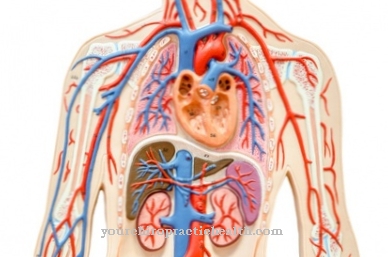The inspiratory reserve volume corresponds to the air that a patient can take in after normal inhalation with forced breathing. Together with the expiratory reserve volume and the tidal volume, the inspiratory reserve volume gives the vital capacity. Lung volumes are measured in spirometry.
What is the inspiratory reserve volume?

Human breathing is characterized by different volumes. These are the individual volumes of the lungs that are taken up by the breath when breathing. The lung volumes are mainly divided into those of inspiration and expiration. The inspiration is inhalation. Expiration refers to breathing out.
The lung capacities are to be distinguished from the lung volumes. They correspond to a combination of different lung volumes. The main volumes of the lungs are the expiratory reserve volume, the residual volume and the inspiratory reserve volume. The tidal volume, on the other hand, is the product of the tidal volume and the respiratory rate.
The inspiratory reserve volume relates to inhalation and corresponds to the volume of space that can also be taken up by air after physiological inspiration through forced breathing. In a healthy adult, the inspiratory and expiratory reserve volume averages around three liters.
Pneumology is concerned with measuring lung volumes. Most lung volumes in this medical field can be determined using spirometry.
Function & task
Active human breathing takes place through the lungs. Their alveoli are primarily responsible for gas exchange. During lung breathing, CO is transported out of the organism via diffusion processes in the alveoli.
Oxygen is absorbed by the alveoli from the air we breathe and transported into the individual tissues of the body via the blood as a transport medium. All body tissue is dependent on oxygen. The cell-internal processes cannot take place without oxygen, so that the body tissue and with it the organs die if there is an insufficient supply of oxygen.
The individual volumes of the lungs ensure that, in the context of lung breathing, enough air can be absorbed for the ideal supply of oxygen to the body tissues. The tidal volume is increased to around three liters with ventilation. These three liters are provided by the reserve volume or the supplementary air. The inspiratory lung volume accounts for around 1.5 liters of this. The remaining 1.5 liters are accounted for by the expiratory reserve volume.
If the physiological breathing air is added to the supplementary air, the result is a maximum air supply of around 3.5 liters. A person can take in this amount of air to the maximum in a single breath. The maximum amount of air you breathe in a single breath is also known as the vital capacity.
After expiration, about 1.5 liters of air remain in the form of the residual volume in the lungs and airways. If the vital capacity and the residual volume are added, the total capacity results.
The respiratory time volume in turn corresponds to the volume of air that a person can breathe in and out within a specified period of time. It corresponds to a multiplication of the respiratory frequency by the tidal volume and amounts to around 7.5 liters per minute at rest.
The breathing limit or minute limit, on the other hand, corresponds to the breathing air volume that can be ventilated at the maximum tidal volume per minute and is on average between 120 and 170 liters for a healthy adult. The vital capacity can be calculated from the inspiratory reserve volume and the expiratory reserve volume with the aid of the tidal volume.
You can find your medication here
➔ Medication for shortness of breath and lung problemsIllnesses & ailments
The expiratory and inspiratory reserve volumes help the pulmonologist as individual values of the vital capacity in determining and differentiating between obstructive and restrictive lung diseases. Obstructive lung diseases are characterized by narrowed airways and are present, for example, in diseases such as asthma or COPD. In the case of restrictive lung diseases, the lungs and the rib cage can only be stretched to a limited extent. This is the case, for example, with pulmonary fibrosis, fluid accumulation as part of a pleural effusion or diaphragmatic palsy.
The vital capacity as the product of the tidal volume and the expiratory and inspiratory reserve volume may help the pulmonologist to classify complaints as obstruction or restriction. For example, the vital capacity is always reduced within the framework of a restriction. This does not necessarily have to be the case with an obstruction.
The measurement of the individual volumes usually takes place within the scope of spirometry, i.e. using a spirometer. The patient receives a mouthpiece that is connected to the measuring spirometer. The patient inhales and exhales through the mouthpiece, following the doctor's breathing instructions. These instructions should be followed with the greatest possible accuracy in order to obtain reliable results. Incorrect measured values can favor misdiagnosis and result in incorrect therapeutic approaches.



























